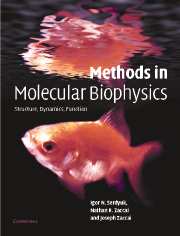Book contents
- Frontmatter
- Contents
- Foreword by D. M. Engelman
- Foreword by Pierre Joliot
- Preface
- Introduction: Molecular biophysics at the beginning of the twenty-first century: from ensemble measurements to single-molecule detection
- Part A Biological macromolecules and physical tools
- Part B Mass spectrometry
- Part C Thermodynamics
- Chapter C1 Thermodynamic stability and interactions
- Chapter C2 Differential scanning calorimetry
- Chapter C3 Isothermal titration calorimetry
- Chapter C4 Surface plasmon resonance and interferometry-based biosensors
- Part D Hydrodynamics
- Part E Optical spectroscopy
- Part F Optical microscopy
- Part G X-ray and neutron diffraction
- Part H Electron diffraction
- Part I Molecular dynamics
- Part J Nuclear magnetic resonance
- References
- Index of eminent scientists
- Subject Index
- References
Chapter C3 - Isothermal titration calorimetry
from Part C - Thermodynamics
Published online by Cambridge University Press: 05 November 2012
- Frontmatter
- Contents
- Foreword by D. M. Engelman
- Foreword by Pierre Joliot
- Preface
- Introduction: Molecular biophysics at the beginning of the twenty-first century: from ensemble measurements to single-molecule detection
- Part A Biological macromolecules and physical tools
- Part B Mass spectrometry
- Part C Thermodynamics
- Chapter C1 Thermodynamic stability and interactions
- Chapter C2 Differential scanning calorimetry
- Chapter C3 Isothermal titration calorimetry
- Chapter C4 Surface plasmon resonance and interferometry-based biosensors
- Part D Hydrodynamics
- Part E Optical spectroscopy
- Part F Optical microscopy
- Part G X-ray and neutron diffraction
- Part H Electron diffraction
- Part I Molecular dynamics
- Part J Nuclear magnetic resonance
- References
- Index of eminent scientists
- Subject Index
- References
Summary
Historical review
T. Wiseman, S. Williston, J. F. Brandts and L. N. Lin published a paper in 1989 with the title: ‘Rapid measurement of binding constants and heats of binding using a new titration calorimeter’. The term isothermal titration calorimetry (ITC) was introduced by E. Freire and colleagues, in 1990. The method is unique in providing not only the magnitude of the enthalpy change upon binding but also, in favourable experimental conditions, values for the binding affinity and entropy changes. Because these parameters fully define the energetics of the binding process, ITC is playing an increasingly important role in the detailed study of protein–ligand interactions and the associated molecular design approaches, in particular with respect to drug design. In the 1990s, a number of critical reviews of ITC results and analytical developments has been published.
Experimental aspects and equations
Measuring protocol and samples
The reaction cell in ITC has a volume close to 1 ml and contains one of the reactants. The other reactant is added to it by injection in small volumes (close to 10 ml), and stirred in. The amount of power (in millijoules per second or in watts) required to maintain a constant temperature difference between the reaction bath and a reference cell is measured by the calorimeter. The heat absorbed or released by the chemical reaction is determined from the integral of the power curve over the appropriate time (Fig. C3.1).
- Type
- Chapter
- Information
- Methods in Molecular BiophysicsStructure, Dynamics, Function, pp. 221 - 233Publisher: Cambridge University PressPrint publication year: 2007



